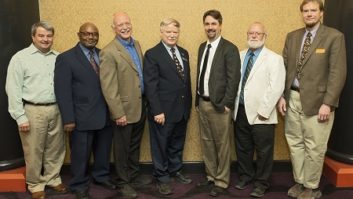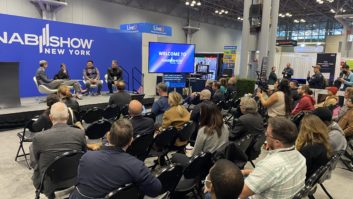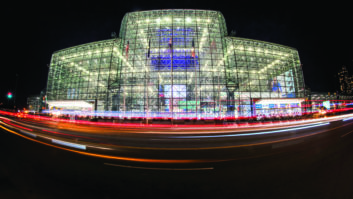Wednesday in the PITS and a Big Lunch – Wednesday, April 13
FUN IN THE PITS
So this is new in 2011. What’s this stage doing in Central Hall? And there’s a rock band up there playing away, complete with two vocalists, two guitars, bass and a drum kit with an isolation booth.
I must have stumbled into one of the PITS. Also known as People Integrating Solutions and Technologies.
These special booths were located throughout the Exhibition Hall and offered hands-on classes demonstrating how to use some of the latest technologies. This year’s offerings included Broadband, Post Production, Pro Audio and Radio. It’s a nice way to take a break from walking in a sea of booths in the convention halls
I got to do a quick multitrack mix of the band’s performance with an iPad running a controller application. The app displays a set of mixer controls with direct feeds from each instrument and vocalist.
Great idea NAB.
LUNCH AND AWARDS
By the time I get to Wednesday the show is really almost over. By the time we get to mid day it’s time for one of my favorite events and I can relax a little.
The Technology Luncheon appeals to most of the engineers attending NAB. The NAB Engineering Achievement awards, one each for Television and Radio every year, are recognition of some of our industry’s most committed members. In the descriptions of the individual achievements of the winners it’s possible to read the history of our broadcast industry.
This year’s award on the radio side went to Bob Du Treil, Sr, well known for his many years of consulting engineering and innovative work in both AM and FM allocation. Congratulations Bob!
Other technical awards include the Technology Innovation Award. In a bit of a surprise for a show with a fairly large majority of television attendees, the NAB honored NPR Labs for its pioneering work on HD Radio and emergency radio notification systems, among other things. This is a well-deserved pat on the back for a research group that is breaking ground in our industry. Congratulations NPR Labs!
See you next year in Vegas.
Genachowski’s Message and Happy Hour – Tuesday, April 12
HERE’S THE PLAN
Julius Genachowski, the chairman of the FCC, generously gave of his time to speak over breakfast to a full house of NAB attendees. The food was watery scrambled eggs and the message was no more pleasant: just give up your spectrum (and your worthless broadcast businesses) already so that we can move on to broadband nirvana for everyone. Under a single wireless carrier that will offer a competitive and market-based future.
Mr. Genachowski is clearly brilliant and a pleasant enough speaker. I would not want to debate him. He has already studied everything and knows all the facts and answers. He will even tell you why your arguments are worthless. Before you have a chance to state them.
In contrast to years past, the Message from the Chairman was a one-sided affair. There was no cozy interview with politely worded questions from the NAB. Nor was there any opportunity for the audience to ask questions- microphones were not provided. The tone of the event was “here’s what you need to do for us.” For some reason the applause at the end of the speech seemed less than enthusiastic. I sense Mr. Chairman is playing with a tiger that is just beginning to wake up.
HAPPY HOUR
I’m not the first to say it but the feeling on the show floor began well and is getting more upbeat as the show continues. I had one exhibitor tell me this was their best show ever. It’s a welcome change from the last two NAB’s which at times had a grim feeling to them. Our industry is beginning to swing back from a down cycle and the good feelings are contagious.
Need more proof? Here’s my informal Happy Hour metric to consider. Starting around 5:00P every day, various exhibitors roll out ice barrels filled with cold beer. Trays of tasty appetizers soon follow. While most affairs are for invitees, no one is taking names and if I were so inclined I could make a pretty good bar crawl, winding my way from the South Halls and back to the Hilton. Where I would find a line of models giving away free shots of aged scotch. Not to mention a number of hospitality booths in full swing by early evening.
Shades of NAB past? I think so, and I’ll raise my glass in a toast to that.
At the NAB Show Opening – Monday, April 11
For a change I decided to attend the NAB Show Opening, a big production event with well over a thousand attendees from all backgrounds. NAB can produce a good show when it wants to and this one was meant to impress.
New NAB President Gordon Smith seems to handle this kind of thing very well-just the right amount of upbeat and welcome. Given the many important regulatory challenges that the broadcasting industry faces he might be just the right type to guide the NAB through a difficult course.
And I have to admit it I felt more than a touch of nostalgia to see Eddie Fritts honored with a Distinguished Service Award. It seemed like old times to have Fritts on stage, talking in an earnest way about his belief in the broadcast industry and the current dangers we face. In my opinion he sees more clearly than most the existential threat to free over-the-air broadcast that is posed by current plans to carve out 500 MHz for broadband wireless.
It struck me again today just what an improvement it has been to consolidate the radio and pro audio exhibitors together in the Central Hall. From the first minute after the exhibits opened the radio hall was full and bursting with people taking a serious look at new equipment. Sure to be hot at the very least are replacement or upgraded EAS systems-only five months remain until the deadline.
In contrast, wandering around the North Hall I saw so many booths where a small cluster of salespeople were quietly talking, only taking a quick glance to see if a passing person might be a potential customer.
So where were all the North Hall customers? Over at the Harris booth of course. Harris had visitors galore and their booth resembles a small city in size, including a cordoned off café area for serious talks. With new radio transmission products (including what has to be the smallest 20 kW FM transmitter today) Harris had lots of attention.
Until tomorrow.
The Calm Before the Storm – Sunday, April 10
Today is the calm before the storm. It’s the official opening of the Broadcast Engineering Conference and primarily it is just that: a conference, with a day full of papers and presentations.
So Sunday is to be enjoyed at a more leisurely pace. The presentations introduce new ideas, products, or research on broadcast technology. Polite questions are asked by the attendees; later in the hallway various clusters of engineers will meet up and debate the value or interest of a particular concept. In fact, it’s in the hallways that much of the show’s energy is felt. Many of us get to see old friends from all over the country but the talk is all about engineering.
Television topics warrant large conference rooms with multimedia displays. This year’s radio sessions took place in rooms that were somewhat…. smaller, and located in the back. But the room was packed from the very beginning, with people standing in the doorway or along the edges. A good sign for this year’s show.
A standout session this morning was Tom Hartnett’s big visionary idea about telephone talk and how to transition from the poor quality cell call to higher quality call-ins on radio shows. The idea is to move consumers to calls over IP, using technologies such as Skype (downloadable on the latest generation of smartphones). I find it ironic that we have to download software and bypass the phone system to make a good quality call on something known as a “smart phone” but I’m on board that this will give us improved sound on our call-in shows. Now, how do we educate our callers?
The afternoon was devoted to IBOC. Asymmetrical sideband operation seems to be on the verge of common adoption, now that iBiquity has come on board. It seems to this observer that with asymmetrical sidebands one of the last major objections to IBOC is being addressed: how to deliver enough digital power so that coverage is better than analog while not causing interference all over the radio dial. Kudos to John Kean at NPR Labs for his coverage and interference models which have helped to demonstrate the success of this approach.
More tomorrow as the floor opens and the big show begins.
Michael LeClair is the Technical Editor of Radio World Engineering Extra.











